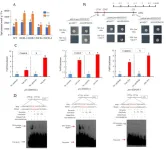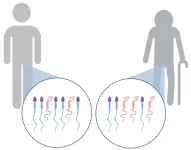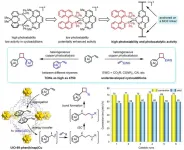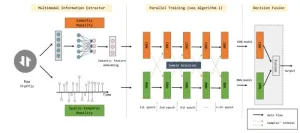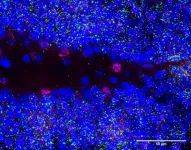(Press-News.org) Researchers have developed a “self-driving” lab that uses artificial intelligence (AI) and automated systems to provide in-depth analyses of catalytic reactions used in chemical research and manufacturing. The new tool, called Fast-Cat, can provide more information in five days than is possible in six months of conventional testing.
At issue are the yield and selectivity of chemical reactions in the presence of molecules called ligands.
Yield refers to how efficiently a chemical reaction produces a desired product from the chemicals you started with. Selectivity refers to the extent to which you can make a chemical reaction produce a specific product instead of creating multiple products. Ligands are widely used in catalysis, speeding up and controlling the selectivity of chemical reactions used in processes ranging from industrial chemistry to pharmaceutical manufacturing.
From an industry perspective, you want the highest possible yield and selectivity. Because the specific steps you take when conducting the catalytic reaction can influence both yield and sensitivity, industrial chemists spend a tremendous amount of time and effort trying to find the parameters necessary to achieve the most desirable reaction outcome.
“The problem is that conventional catalyst discovery and development techniques are time-, material- and labor-intensive,” says Milad Abolhasani, corresponding author of a paper on the work and an associate professor of chemical and biomolecular engineering at North Carolina State University. “These techniques rely largely on manual sample handling with batch reactors, as well as human intuition and experience to drive the experimental planning. In addition to the material inefficiencies, this human-dependent approach to catalyst development creates a large time gap between performing the reaction, characterizing the product, and making a decision about the next experiment.
“That’s why we created Fast-Cat. We’re now able to better understand how a specific ligand performs in five days than was previously possible in six months.”
Fast-Cat is completely autonomous, using AI and automated systems to continuously run high-temperature, high-pressure, gas-liquid reactions. The autonomous technology also analyzes the output from each of these reactions to determine – with no human intervention – how different variables affect the outcome of each experiment.
Fast-Cat uses the results from all of the previous experiments it has run – both successes and failures – to inform which experiment it will run next.
“Fast-Cat’s AI is constantly evolving, learning from the experiments it has already conducted,” Abolhasani says.
In layman’s terms, users let Fast-Cat know what ligands and precursor chemicals it has to start with, and then see how much it can learn over 60 experiments.
“We spent a lot of time fine-tuning Fast-Cat’s AI model to optimize its ability to provide the broadest possible understanding of how different parameters affect the selectivity and yield of catalytic reactions using a specific ligand,” Abolhasani says. “We also spent a lot of time ensuring that Fast-Cat’s findings are scalable. Fast-Cat conducts its experiments with extremely small sample sizes. But if we want its findings to be relevant for practical use, we needed to know that Fast-Cat’s findings hold true for reactions conducted on the large scales that are relevant for industrial manufacturing.”
For proof-of-concept testing, the researchers used Fast-Cat to characterize the catalytic performance of six ligands that are already found in the research literature.
“This technology is providing in-depth optimization of each unique ligand,” says Dawn Mason, global external innovation manager at Eastman, a global specialty materials company that supported the work. “For the first time, we are able to quickly assess a wide variety of parameters and gain a truly in-depth understanding of how to influence the performance of each ligand. We more than doubled the array of possible selectivity and yield endpoints for each ligand examined. Incredibly, it only took five days to assess each one.”
“There is genuine value for the chemical and pharmaceutical industries in better understanding how to influence the catalytic processes they use in manufacturing,” says Jeff Carbeck, vice president of corporate innovation at Eastman. Fast-Cat provides that understanding – and does so quickly, efficiently, and while using tiny amounts of the relevant ligands and chemical precursors. In other words, it’s fast, inexpensive, and very effective.”
The researchers have made the software and hardware publicly available so that Fast-Cat can be used to facilitate additional research.
“We hope other researchers can adopt this technology to accelerate catalysis discovery in academia and industry,” Abolhasani says.
The paper, “Autonomous Reaction Pareto-Front Mapping with a Self-driving Catalysis Lab,” will be published February 27 in the journal Nature Chemical Engineering. The paper was co-authored by Jeffrey Bennett, a postdoctoral researcher at NC State; Negin Orouji and Sina Sadeghi, who are both Ph.D. students at NC State; Muzammil Khan, a former postdoctoral researcher at NC State; and Jody Rodgers of Eastman.
The research was made possible by a grant from Eastman.
END
AI-driven lab speeds catalysis research
2024-02-27
ELSE PRESS RELEASES FROM THIS DATE:
Unveiling the sustainability landscape in cultural organizations: A global benchmark
2024-02-27
Are museums, theaters, and opera houses truly walking the talk when it comes to social and environmental sustainability? The University of Lausanne (UNIL) delved into this pressing question, conducting an international survey with over 200 major cultural organizations. The verdict? While there's significant room for improvement across the spectrum, Anglophone countries lead the charge.
Cultural organizations, with their wide-reaching influence and power to shape narratives and imaginations, are poised to ...
The mechanism of SlWRKY80 participating in salt alkali stress through its involvement in JA metabolic pathway
2024-02-27
Tomato (Solanum lycopersicum L.) is the most widely cultivated and consumed horticultural crop. At present, saline–alkali is an important abiotic stress source that affects tomato production. Exogenous methyl jasmonate (MeJA) can enhance the resistance of tomatoes to various stress, but its exact mechanism is still unclear.
In January 2024, Horticulture Research published a research entitled by “SlWRKY80-mediated jasmonic acid pathway positively regulates tomato resistance to saline-alkali stress by enhancing spermidine content and stabilizing ...
Abdominal fat can impact brain health and cognition in high Alzheimer’s risk individuals
2024-02-27
The impact of abdominal fat on brain health and cognition is generally more pronounced in middle-aged men at high risk of Alzheimer’s disease as opposed to women, according to researchers at Rutgers Health.
In middle-aged individuals with a family history of Alzheimer’s disease, the amount of fat in their abdominal organs (pancreas, liver, and belly fat) is related to their brain volumes and cognitive function, according to the study published in the journal Obesity. The study was written by Sapir Golan Shekhtman, a Ph.D. student at the Joseph Sagol Neuroscience Center at the Sheba Medical Center in Israel and led by ...
New data analysis supports hedonic overdrive model in high-fat diet-induced mice
2024-02-27
ROCKVILLE, Md.— High-fat diets cause obesity in male mice. The underlying mechanism, however, remains controversial. After assessing three contrasting ideas, researchers have determined that the hedonic overdrive model provides the best fit, according to a new study published in the journal Obesity, The Obesity Society’s (TOS) flagship journal.
“Our work provides some direction as to why high-fat/high-carb macronutrient combinations stimulate overconsumption. The study is in mice so we ...
Pythagoras was wrong: there are no universal musical harmonies, new study finds
2024-02-27
The tone and tuning of musical instruments has the power to manipulate our appreciation of harmony, new research shows. The findings challenge centuries of Western music theory and encourage greater experimentation with instruments from different cultures.
According to the Ancient Greek philosopher Pythagoras, ‘consonance’ – a pleasant-sounding combination of notes – is produced by special relationships between simple numbers such as 3 and 4. More recently, scholars have tried to find psychological explanations, but these ‘integer ratios’ are still credited with making a chord sound beautiful, and deviation from them ...
Researchers uncover new clues about links between parent age and congenital disorders
2024-02-27
A new paper in Genome Biology and Evolution, published by Oxford University Press, finds that the link between paternal age and rare congenital disorders is more complex than scientists had previously thought. While researchers have long realized that older fathers are more likely to have children with bone and heart malformations, such as Achondroplasia, Apert, or Noonan syndrome or neurodevelopmental disorders, schizophrenia, and autism, new examination indicates that while the link between some pathogenic mutations increases with paternal age, others do not and may even occur in the father’s testis before sexual maturity.
Delayed fatherhood results in a higher ...
Study reveals parental smoking and childhood obesity link transcends socio-economic boundaries
2024-02-27
A study into parental smoking and childhood obesity has challenged previous notions by revealing that the links between the two are not confined to a specific socio-economic group.
The data shows a strong correlation between parents who smoke and their children’s consumption of high calorie unhealthy foods and drinks, across social classes.
Using longitudinal data on 5,000 Australian children collected over a 10-year period, the research found those living with parents who smoke, on average, eat less healthy, higher calorie food such as fruit juice, sausages, fries, snacks, full fat milk products, ...
HKU chemists pave the way for sustainable organic synthesis with innovative heterogeneous copper photocatalysis, enabling efficient production of diverse bioactive compounds
2024-02-27
Professor Jian HE, from the Department of Chemistry at The University of Hong Kong (HKU), has spearheaded a research endeavour aimed at revolutionising organic synthesis. His research team has successfully developed a novel heterogeneous copper photocatalyst that enables the efficient formation of cyclobutane rings, a crucial structural element in a vast array of bioactive molecules. Cyclobutane rings are prominently featured in pharmaceuticals, natural products, and various biologically active compounds. By enabling researchers to construct these rings easily and selectively, ...
Using multimodal deep learning to detect malicious traffic with noisy labels
2024-02-27
The success of a deep learning-based network intrusion detection systems (NIDS) relies on large-scale, labeled, realistic traffic. However, automated labeling of realistic traffic, such as by sand-box and rule-based approaches, is prone to errors, which in turn affects deep learning-based NIDS.
To solve the problems, a research team led by Yuefei ZHU published their new research on 15 Feb 2024 in Frontiers of Computer Science co-published by Higher Education Press and Springer Nature.
The team ...
Learning and memory problems in down syndrome linked to alterations in genome's ‘dark matter’
2024-02-27
Researchers at the Centre for Genomic Regulation (CRG) reveal that the Snhg11 gene is critical for the function and formation of neurons in the hippocampus. Experiments with mice and human tissues revealed the gene is less active in brains with Down syndrome, potentially contributing to the memory deficits observed in people living with the condition. The findings are published today in the journal Molecular Psychiatry.
Traditionally, much of the focus in genomics has been on protein-coding genes, which in humans constitutes around just 2% of the entire genome. The rest is "dark ...

